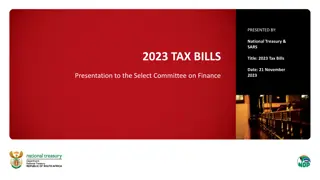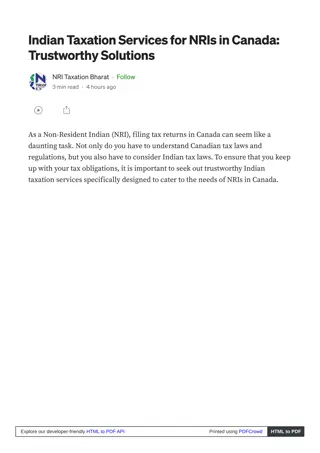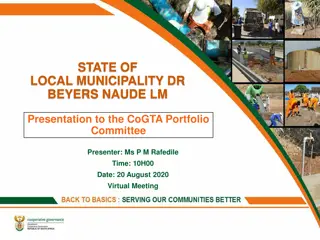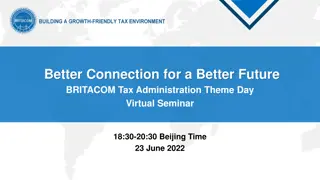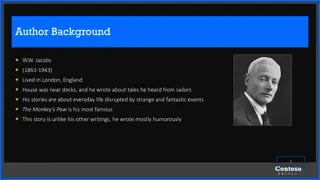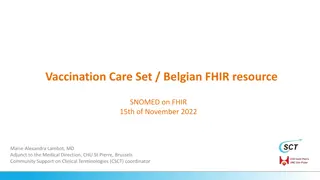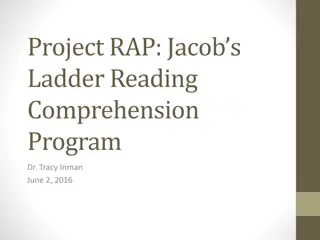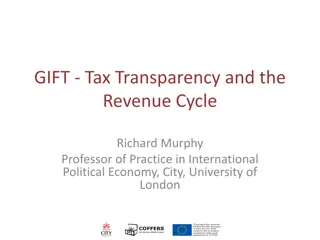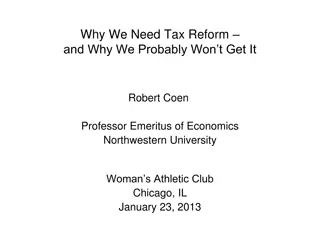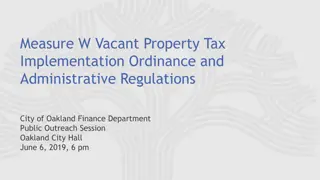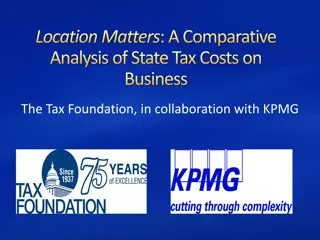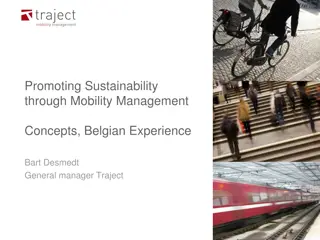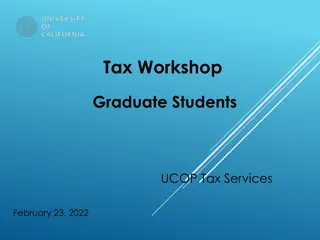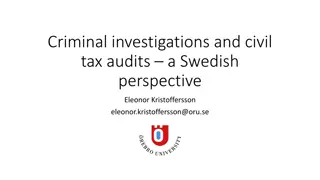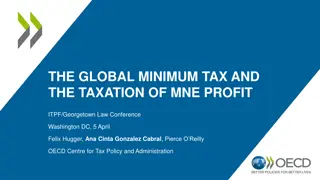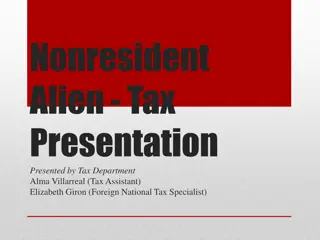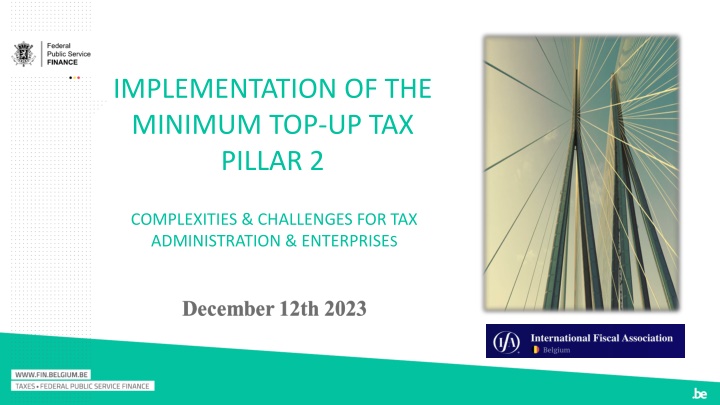
Implementing Minimum Top-Up Tax: Complexities & Challenges for Tax Administration and Enterprises
Explore the complexities and challenges surrounding the implementation of the minimum top-up tax under Pillar 2. Dive into the three layers of legislation, key steps, milestones, and group approaches for MNEs to ensure compliance and auditing. Understand how businesses and tax administrations navigate the intricacies of this tax framework.
Uploaded on | 0 Views
Download Presentation

Please find below an Image/Link to download the presentation.
The content on the website is provided AS IS for your information and personal use only. It may not be sold, licensed, or shared on other websites without obtaining consent from the author. If you encounter any issues during the download, it is possible that the publisher has removed the file from their server.
You are allowed to download the files provided on this website for personal or commercial use, subject to the condition that they are used lawfully. All files are the property of their respective owners.
The content on the website is provided AS IS for your information and personal use only. It may not be sold, licensed, or shared on other websites without obtaining consent from the author.
E N D
Presentation Transcript
IMPLEMENTATION OF THE MINIMUM TOP-UP TAX PILLAR 2 COMPLEXITIES & CHALLENGES FOR TAX ADMINISTRATION & ENTERPRISES
AGENDA 4. Three layers of legislation 7. Data 1. Intro P2 8. Dialogue with business & consultants P2 5. Processes & applications & tools implementation 2. Milestones for implementation 3. Group approach MNE s in compliance & auditing 6. People : organizational aspects P2 9. Q&A
1. INTRO - OVERVIEW PILLARS Amount A = Re-allocation of taxing rights Amount B = Special considerations for baseline marketing and distribution activities Pillar 1 Pillar 2 = MNEs pay fair share of tax wherever they operate Domestic rules = QDMTT + Global anti-Base Erosion mechanism (IIR & UTPR) Treaty-based rule = Subject to tax rule (STTR)
1. INTRO - SIX KEY STEPS OF THE TOP-UP TAX 1 Determine whether the MNE Group is within scope 2 Allocate income of Constituent Entities on a Jurisdictional Basis 3 Calculate the GloBE Income 4 Determine Adjusted Covered taxes 5 Compute the Effective Tax Rate and calculate the Top-up Tax 6 Charge the Top-up Tax under QDMTT, IIR or UTPR
! ATTENTION ! FRAMEWORK STILL UNDER CONSTRUCTION 2. MILESTONES FOR IMPLEMENTATION 2024 2025 2026 Q2: Notification group number Q2: Filing the Globe Information Return (GIR) Q4 : Tax return QDMTT Q2/Q3: Notification prepayments Q3 2026 = Tax return IIR Q3 2026 = Making remaining payments Q3/Q4: making prepayments Q4: Notification Tax returns (QDMTT and IIR) & GIR
3. GROUP APPROACH MNES IN COMPLIANCE & AUDITING Focus on group level: Company = part of larger picture in MNE context Challenges: Group approach + compliance - audit" approach requires flexibility of our agents Relationships between companies = important = FAR analysis Mapping all interactions and risks within a (multi)national group (not only for TP/P2 purposes) = holistic approach Joining forces and strengthening each other is key to success!
4. THREE LAYERS OF LEGISLATION OECD AS IS Model GloBE Rules Commentary Administrative Guidance Examples GloBE Information Return Safe Harbours and Penalty Relief Implementation Handbook TO BE Administrative guidance EU BELGIUM AS IS Parliament 55K3678 Election to apply a qualified domestic top-up tax system Prepayments AS IS Council Directive (EU) 2022/2523 of 14.12.2022 Also, for large-scale domestic groups in the EU TO BE FAQ s TO BE Additional legislation
5. PROCESSES & APPLICATIONS & TOOLS IMPLEMENTATION Launch of project early 2024 to implement Pillar Two: technical and organisational solution. Momentarily : launch of Business Case 3 different sub phases 1st phase : organising notification system for MNE s and large-scale domestic groups for Pillar Two. Belgium : important aspect: prepayments system for QDMTT and IIR 2nd phase : development of e-services for MNE s and large-scale domestic groups for, a.o., filing of tax returns and GIR, as well as development of back office applications. 3rd phase : creation of structure for international exchange of information. Important = reciprocal input from all necessary stakeholders within FPS Finance attention for the multidimensional impact of the implementation
6. PEOPLE : ORGANIZATIONAL ASPECTS P2 Staffing P2 Team LE & OES : pioneers Training program : Accounting / CIT / TP / IFRS / P2 Workgroup implementation P2 : follow up development implementation P2 Large Enterprises Unit : focus on four different areas : Compliance / Risk analysis / Audit / Disputes 116 employees in total profiles = tax accountants & international taxation
7. DATA FINDING THE RIGHT BALANCE BETWEEN TRUST TRANSPARENCY Several notifications & tax returns GIR = lots of tables (> 50) with lots of datapoints Strong need for different ICT Tools (internal & external) Interlink between TP / CIT / P2 Link with other data sources TECHNOLOGY
8. DIALOGUE WITH BUSINESS & CONSULTANTS P2 What are the issues Pilar Two? and needs of the business? Exploring the possibility to start up a dialogue with the business & consultants (external stakeholders) concerning the implementation of Pillar Two What is the implementation plan? Business are concerned !
Q & A Q & A

